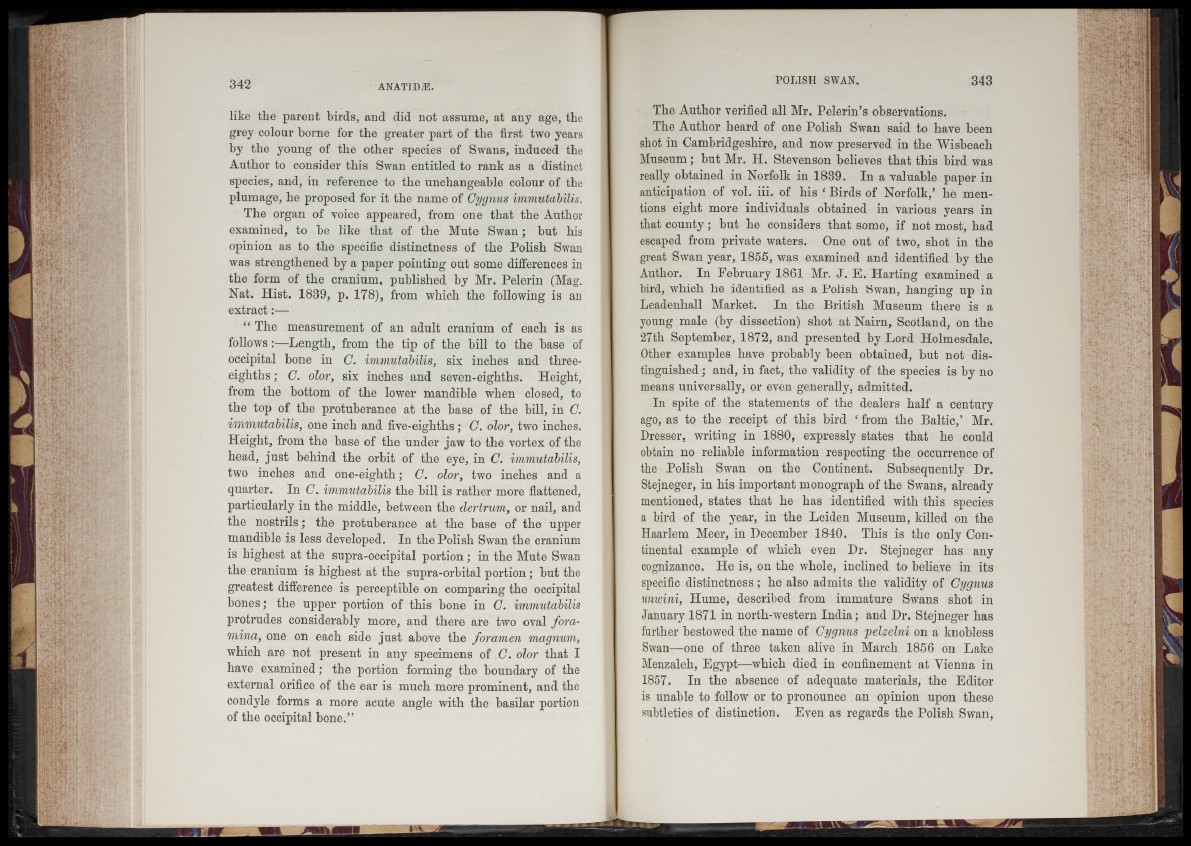
like the parent birds, and did not assume, at any age, the
grey colour borne for the greater part of the first two years
by the young of the other species of Swans, induced the
Author to consider this Swan entitled to rank as a distinct
species, and, in reference to the unchangeable colour of the
plumage, he proposed for it the name of Cygnus immutabilis.
The organ of voice appeared, from one that the Author
examined, to he like that of the Mute Swan; but his
opinion as to the specific distinctness of the Polish Swan
was strengthened by a paper pointing out some differences in
the form of the cranium, published by Mr. Pelerin (Mag.
Nat. Hist. 1839, p. 178), from which the following is an
extract:—
“ The measurement of an adult cranium of each is as
follows:—Length, from the tip of the bill to the base of
occipital bone in C. immutabilis, six inches and three-
eighths; C. olor, six inches and seven-eighths. Height,
from the bottom of the lower mandible when closed, to
the top of the protuberance at the base of the bill, in C.
immutabilis, one inch and five-eighths; C. olor, two inches.
Height, from the base of the under jaw to the vortex of the
head, just behind the orbit of the eye, in C. immutabilis,
two inches and one-eighth; C. olor, two inches and a
quarter. In C. immutabilis the hill is rather more flattened,
particularly in the middle, between the dertrum, or nail, and
the nostrils; the protuberance at the base of the upper
mandible is less developed. In the Polish Swan the cranium
is highest at the supra-occipital portion; in the Mute Swan
the cranium is highest at the supra-orhital portion; but the
greatest difference is perceptible on comparing the occipital
hones; the upper portion of this hone in C. immutabilis
protrudes considerably more, and there are two oval foramina,
one on each side just above the foramen magnum,
which are not present in any specimens of C. olor that I
have examined; the portion forming the boundary of the
external orifice of the ear is much more prominent, and the
condyle forms a more acute angle with the basilar portion
of the occipital bone.”
The Author verified all Mr. Pelerin’s observations.
The Author heard of one Polish Swan said to have been
shot in Cambridgeshire, and now preserved in the Wisbeach
Museum; but Mr. H. Stevenson believes that this bird was
really obtained in Norfolk in 1839. In a valuable paper in
anticipation of vol. iii. of his ‘ Birds of Norfolk,’ he mentions
eight more individuals obtained in various years in
that county ; hut he considers that some, if not most, had
escaped from private waters. One out of two, shot in the
great Swan year, 1855, was examined and identified by the
Author. In February 1861 Mr. J. E. Harting examined a
bird, which he identified as a Polish Swan, hanging up in
Leadenhall Market. In the British Museum there is a
young male (by dissection) shot at Nairn, Scotland, on the
27th September, 1872, and presented by Lord Holmesdale.
Other examples have probably been obtained, but not distinguished
; and, in fact, the validity of the species is by no
means universally, or even generally, admitted.
In spite of the statements of the dealers half a century
ago, as to the receipt of this bird ‘ from the Baltic,’ Mr.
Dresser, writing in 1880, expressly states that he could
obtain no reliable information respecting the occurrence of
the Polish Swan on the Continent. Subsequently Dr.
Stejneger, in his important monograph of the Swans, already
mentioned, states that he has identified with this species
a bird of the year, in the Leiden Museum, killed on the
Haarlem Meer, in December 1840. This is the only Continental
example of which even Dr. Stejneger has any
cognizance. He is, on the whole, inclined to believe in its
specific distinctness ; he also admits the validity of Cygnus
unwini, Hume, described from immature Swans shot in
January 1871 in north-western India; and Dr. Stejneger has
further bestowed the name of Cygnus pelzelni on a knobless
Swan—one of three taken alive in March 1856 on Lake
Menzaleh, Egypt—which died in confinement at Vienna in
1857. In the absence of adequate materials, the Editor
is unable to follow or to pronounce an opinion upon these
subtleties of distinction. Even as regards the Polish Swan,